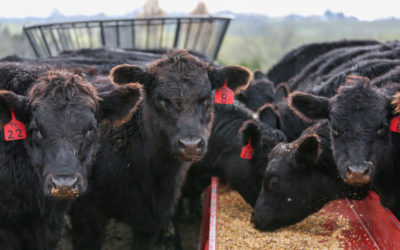That is adaptability
Adaptable (adjective): able to adjust oneself readily to various conditions
On Monday evening a few weeks ago, I began my internship with the Black Ink team. I was nervous. While it’s exciting, the unknown terrifies me, and the possibility of making mistakes and the nagging thought of being in over my head weighed heavily on my mind.
That Wednesday afternoon, we traveled to Stratton, Colo., where we met Jerry Hasart and I heard how Top End Farms stepped into the unknown several times throughout the years and adapted.
The 99-year-old family operation switched to running straight Angus commercial cows 14 years ago, and seven years ago went to a natural program. Jerry’s reason for the change was mere resources….or lack thereof.
“It was just me and my brother with kids that were still in high school. That was my work force,” Jerry says, noting it was as not a large ranch. It required more paperwork to meet the qualifications, but they knew could make up in premiums. “We thought this opportunity would work well for our program.”
And it has, although Jerry is the first to admit that the hardest part was failure.
“Failure of not meeting the standards through humane handling or documentation. Still there. We’ve been doing this calf deal before. But this was a lot different.”
Jerry had to take another look at how they handled their cattle. After attending a few Tom Noffsinger schools on low stress cattle handling, Jerry and his family ditched their hot shots and perfected their skills.
That is adaptability.
“You didn’t have to whoop and holler. The rule of thumb is, they don’t know any curse words,” Jerry explains. “They do not know Japanese, Chinese, Korean, Spanish or American. All they know is how you react to them.”
Throughout our visit the grey-haired, Colorado-weathered cattleman constantly had a smile in his eyes while talking about his cows. “It’s been fun,” he says repeatedly of the Angus genetics they have developed, and even of the drought that hit Colorado in 2011 and 2012.
It was during that weather challenge that Jerry and his brother decided that they could either expand locally—but risk future water shortages—or they could expand elsewhere, to a place where water was more readily available. That place happened to be nearly 400 miles away, near Valentine, Neb., where Jerry’s brother currently runs nearly 700 Angus cows.
Adaptability.
While the drought forced the family to learn how to run cattle together in a long distance partnership, it’s not the first time that Top End Farms has been inventive in dealing with challenges.
Without antibiotics, weaning proved difficult, but just last year the Hasarts held sickness to just 1%, which means very few calves received treatment, and few were removed from the natural program. Both ranch locations have developed low-stress weaning systems that work for them.
“It’s all still a big learning process,” says Jerry. “The most exciting thing about feeding Angus cattle and watching them grow, is when they go on the truck. When they fill up the chute, going into the truck, it’s a happy day.”
And with the way Top End Farms can adapt to what comes their way, I think they have many happy days ahead of them; not very different than myself, having finally adapted to my internship, which isn’t nearly as scary now.
Adaptability.
–Hannah

You may also like
New calf marketing routes
For the 70% or more of beef calves born last spring, more than the usual share veered from traditional roads to the feedyard come fall. Backgrounding those calves opened gates to several new revenue paths, though not without risk.
Progress from small steps
Every day is a chance to learn and get better. Thousands of others like my new friends in Alabama are taking steps to meet the shifts in consumer demand, and to know more. Small steps in the right direction can start now. Even if it’s just recording a snapshot of where you are today, a benchmark for tomorrow.
Not perfect, but working to get better
The CAB Cattleman Connection team heard its name called more than once in the virtual ceremonies, and each time came a sense of personal accomplishment, but even better: confirmation that we’re getting better at our craft. I hope that means we’re doing a better job for you.





